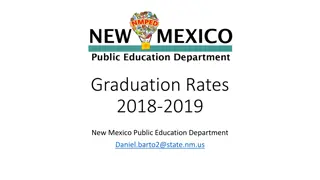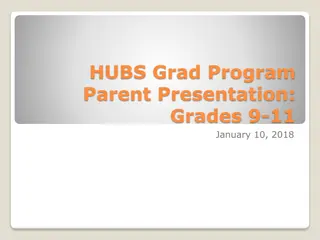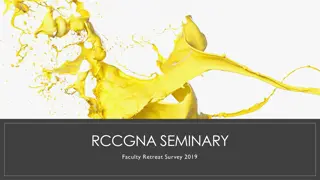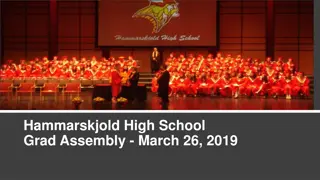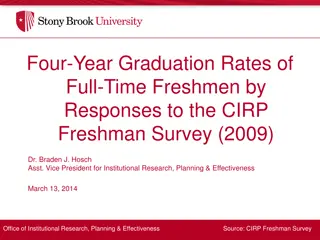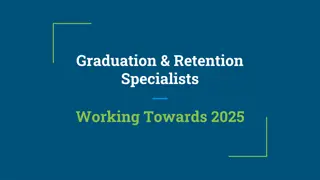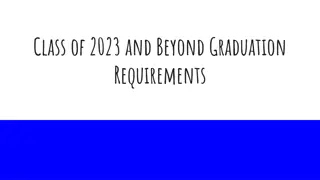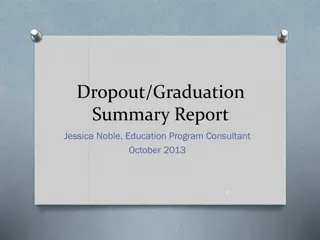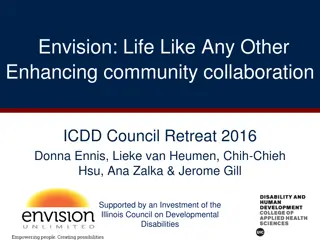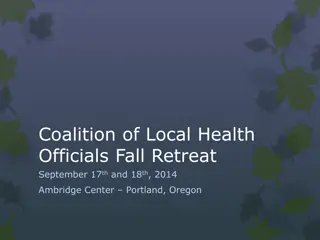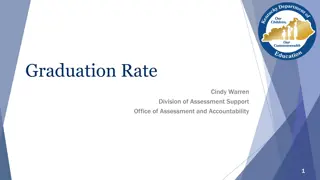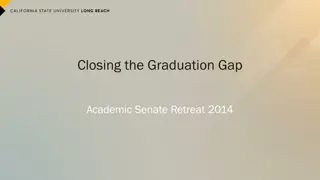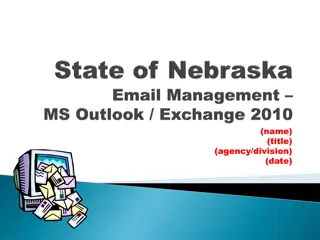Understanding Sophomores Council on Retention and Graduation (CRG) Fall Retreat Overview
The presentation delves into the focus on sophomores, their unique needs and challenges, predictors of success, and implications for practice. It highlights the critical period of transition during the second year of college, addressing issues such as academic success outcomes, financial concerns, and interventions for student thriving and success. The insights shared aim to sustain student success beyond the first year of college.
Download Presentation

Please find below an Image/Link to download the presentation.
The content on the website is provided AS IS for your information and personal use only. It may not be sold, licensed, or shared on other websites without obtaining consent from the author. Download presentation by click this link. If you encounter any issues during the download, it is possible that the publisher has removed the file from their server.
E N D
Presentation Transcript
Understanding Sophomores Council on Retention and Graduation (CRG) Fall Retreat Michele J. Hansen, Ph.D., Executive Director of Research, Planning, and Evaluation, UC December 14, 2015
CRG Sophomores December 14, 2015 Presentation Overview Why focus on Sophomores? Are their needs different? What are the characteristics, needs of, and academic success outcomes for Sophomores at IUPUI? What are predictors of successful completion of Sophomore year? What are some implications for practice?
CRG Sophomores December 14, 2015 Why Focus on Sophomores? "For years, student-centered institutions have front-loaded resources to promote student success in the first college year. George D. Kuh How can we and why should we sustain this important work in the second year of college?
CRG Sophomores December 14, 2015 Sophomore Challenges Second year of college critical period of transition, adjustment, and potential confusion Potential confusion as leave the safety and security of very structured and directed first-year programs May feel disconnected and overwhelmed with their new reality Feel increased pressure, especially to declare or commit to a major, and decreased support. Reduced motivation when taking General Education courses Sources: 2011 Noel-Levitz, Inc. 2011 National Pilot Study/Research Report The Attitudes of Second- Year College Students Schreiner, Miller, Pullins, &Seppelt, 2012
CRG Sophomores December 14, 2015 Sophomore Needs Meaning in the selection of a major New friendships A career of interest Financial solutions for their educational and living expenses and debt. 2011 Noel-Levitz, Inc. 2011 National Pilot Study/Research Report The Attitudes of Second-Year College Students
CRG Sophomores December 14, 2015 Interventions for Second Year Student Success and Thriving May Focus On Academic concerns Leadership Majors and careers Community service Improved faculty-student interactions Finances and financial literacy Social and personal relationships 2011 Noel-Levitz, Inc. 2011 National Pilot Study/Research Report The Attitudes of Second-Year College Students
CRG Sophomores December 14, 2015 Financial Concerns Can be Overwhelming!
CRG Sophomores December 14, 2015 Thriving Sophomores High sense of community on campus Positive interactions with faculty members Being certain or confident about one s major Not overwhelmed by college debt High levels of effort and motivation Being a transfer student Schreiner, Miller, Pullins, & Seppelt, 2012
CRG Sophomores December 14, 2015 Indianapolis Only FT, FT Cohort Retention and Graduation Rates (Bachelor, Associate, and Certificate) 80% 75% 70% 74% 74% 74% 73% 73% 72% 70% 67% 67% 67% 66% 65% 60% 64% 62% 50% 1-year retention 46% 46% 40% 44% 4-year graduation 40% 6-year graduation 35% 35% 30% 33% 33% 32% 28% 20% 22% 20% 20% 19% 16% 15% 10% 12% 12% 0% 2000 2001 2002 2003 2004 2005 2006 2007 2008 2009 2010 2011 2012 2013 2014
CRG Sophomores December 14, 2015 Fall 2009 FT, FT Indianapolis Only Fall-to-Fall Retention Rates 75% 80% 64% 70% 59% 56% 60% 50% 40% Retention Rate 30% 20% 10% 0% 1 Year 2 Year 3 Year 4 Year
CRG Sophomores December 14, 2015 Fall 2010 FT, FT Indianapolis Only Fall-to-Fall Retention Rates 80% 73% 70% 62% 59% 57% 60% 50% 40% Retention Rate 30% 20% 10% 0% 1 Year 2 Year 3 Year 4 Year
CRG Sophomores December 14, 2015 Fall 2011 FT, FT Indianapolis Only Fall-to-Fall Retention Rates 74% 80% 70% 63% 57% 54% 60% 50% 40% Retention Rate 30% 20% 10% 0% 1 Year 2 Year 3 Year 4 Year
CRG Sophomores December 14, 2015 Fall 2012 FT, FT Indianapolis Only Fall-to-Fall Retention Rates 80% 73% 70% 63% 59% 60% 50% 40% Retention Rate 30% 20% 10% 0% 1 Year 2 Year 3 Year 4 Year
CRG Sophomores December 14, 2015 Fall 2013 FT, FT Indianapolis Only Fall-to-Fall Retention Rates 80% 72% 70% 63% 60% 50% 40% Retention Rate 30% 20% 10% 0% 1 Year 2 Year 3 Year 4 Year
CRG Sophomores December 14, 2015 Definitions of Class Standing Freshman 0 - 29 credit hours earned Sophomore 30 - 59 credit hours earned Junior 60 - 89 hours credit hours earned Senior 90 or more hours credit hours earned
CRG Sophomores December 14, 2015 Current Sophomores at IUPUI Fall 2015 Fall 2015 Sophomore Profile All IUPUI, Indianapolis Only Undergraduates With 30 to 59 Credit Hours Earned Toward Their First Baccalaureate or Lower Degree Handout Provided
CRG Sophomores December 14, 2015 Current Sophomores at IUPUI Fall 2015 Highlights 4232 Total Students Transfer Undergraduate (28%) Majority Female (54%) Majority 22 years of age or under (83%) 25 years of age or older (11%) African American (10%) and Latino (7%) First Generation (32%) High School GPA 3.5 or higher (26%) Currently Earning GPAs less than 2.5 (24%) *Approximately 11% have no GPA on file (transfer students or beginning freshmen with 30+ hours of pre-college credit)
CRG Sophomores December 14, 2015 Current Sophomores at IUPUI Fall 2015 School of Major University College (43%) Engineering and Technology (12%) Science (11%) Liberal Arts (7%) Education (4%) Business (4%)
CRG Sophomores December 14, 2015 Some Facts About Most Recent Cohort (FT, FT 2014 Indianapolis Only N=3450) 1978 (57%) Attained Sophomore Status after their first year 1805 (52%) Students Attained Sophomore Status after their first year and were retained 150 (4%) Attained Junior Status after 1 year
CRG Sophomores December 14, 2015 Students Who Attained Sophomore and Not Retained Variable Sophomore Retained (1805) Sophomore Not Retained (173) Avg. H.S. GPA 3.49 3.43 Avg. SAT Score 1055 1019 Avg. Earned Dual Credit 9.5 11.0 % Earned Dual Credit 52% 57% % H.S. Honors Diploma 70% 73% % Earned AP Credit 19% 14% % African American 7% 8% % Pell Grant 39% 48% % FY GPA Below 2.0. 2% 17% % First-Year Seminar 95% 95% % Out of State 5% 6%
CRG Sophomores December 14, 2015 Understanding Transitions: Most Recent IUPUI Indianapolis Only Cohort Fall 2014 FT, FT One-Year Retention One = 2566 (74%) Academically Dismissed 328 (10%) Examination of students who successfully became Sophomores (earned 30 or more credit hours after their first year and enrolled in fall 2015 or were retained).
CRG Sophomores December 14, 2015 Most Recent Students Who Attained Sophomore or Junior Status by End of First Year Total Number = 2128 (62% of those enrolling in third semester were Sophomores or Juniors) Average credit hours earned Range of credit hours earned 40.5 28 - 106 Average credit hours earned from dual enrollment (excluding AP and SPAN) 6.2 Number of students earning dual credit (excluding AP and SPAN) Range of credit hours earned 1156 1 - 60
CRG Sophomores December 14, 2015 Comparing Students Attained Sophomore or Junior Status to Those Who Did Not By End of First Year Variable Sophomore or Higher (30 or more credits) Avg. H.S. GPA 3.51 Avg. SAT Score 1064 Avg. Earned Dual Credit 6.21 % Earned Dual Credit 54% % Earned AP Credit 21% % H.S. Honors Diploma 71% Avg. Units of H.S. Math 7.65 Avg. FY GPA 3.17 Not Sophomore (under 30 credits) 3.20 986 1.29 19% 6% 44% 7.10 1.99
CRG Sophomores December 14, 2015 Comparing Students Attained Sophomore Status to Those Who Did Not By End of First Year Variable Sophomore (25 or more credits) % Female 61% % African American % Latino (a) % 25 or older % Pell Grant Received 39% % Campus Housing 44% Not Sophomore (under 25 credits) 55% 10% 2% 3% 1% 5% 1% 49% 25%
CRG Sophomores December 14, 2015 Commitments, Attitudes, and Academic Hope Variable Sophomore or Junior (25 or more credits) Not Sophomore (under 25 credits) 21% Percentage of students planning to work more than 20 hours a week off-campus 11% It is important for me to graduate from IUPUI (strongly or moderately agree) 65% 64% There is no or very little chance that I would change my major 69% 64% Average Academic Hope 6.89 5.52 5.96 6.77 5.45 5.92 Average Sense of Belonging Average Positive Institutional Commitment
CRG Sophomores December 14, 2015 Intended Major School of Students Not Attaining Sophomore Status (N = 1322) School of Intended Major Science Business University College Nursing Engineering Medicine Technology Physical Education Dentistry Education N % 245 175 171 133 132 68 64 54 48 47 19% 13% 13% 10% 10% 5% 5% 4% 4% 4% Note: Intended major is as of census of fall 2014
CRG Sophomores December 14, 2015 Intended Majors of Students Not Attaining Sophomore Status (N = 1334) Intended Major Exploratory Baccalaureate Pre Nursing BSN Pre Biology BS PU Pre Management BSB Pre Dental Hygiene AS Pre Business BSB Pre-Fine Arts - Herron Pre Accounting BSB N % 171 133 48 46 41 39 37 30 13% 10% 4% 3% 3% 3% 3% 2% Note: Intended major is as of census of fall 2014
CRG Sophomores December 14, 2015 Predictors of Successful Completion of Sophomore Year (Thriving) Being Academically Prepared (Higher H.S. GPAs, SAT Scores, Proportion Earning Honors Diplomas, AP Credit) More likely to be in IUPUI Honors College (13% vs. 3%) More Units of H.S. Math, Higher Level (Calculus), and Completed Math Course More Recently (0-2 months ago) Performing Well Academically the First Year of College Higher Levels of Academic Hope at Entry (At the present time, I am energetically pursing my academic goals). More likely to Understand Importance of Interacting with Faculty Members Outside of Class at Entry Being Careful in Completing High School Assignments and Completing Them On-Time (proxy for motivation and persistence)
CRG Sophomores December 14, 2015 Risk Factors Associated with Not Completing Sophomore Year Being Low Income (more likely to receive Pell Grant or Financial Aid at Entry) Being First Generation Being Male Living Off-Campus First Year Being in Underrepresented Minority Group Spending Significant Time Engaged in Nonacademic Activities
CRG Sophomores December 14, 2015 Planned Time Commitments (Expects to spend 20 or more hours per week) Successful Sophomore Year Not Successful Preparing for Class 56% 46% Working On-Campus 17% 17% Working Off-Campus 25% 38% Relaxing and Socializing 14% 17% Caring for Dependents 4% 6% Commuting to Class 10% 13% Co-Curricular Activities 15% 14% Volunteering 7% 6%
CRG Sophomores December 14, 2015 Intended Major School of Fall 2013 FTFT Beginners Not Completing Sophomore Year (N = 1842) School of Intended Major University College Science Business Nursing Engineering Medicine Technology Dentistry Education Note: Includes all first-time, full-time beginners in fall 2013 who had not completed 60 hours by census of fall 2015. Intended major is as of census of fall 2013. N % 259 252 228 220 215 109 92 76 62 14% 14% 12% 12% 12% 6% 5% 4% 3%
CRG Sophomores December 14, 2015 Intended Majors of Students Not Completing Sophomore Year (N = 1842) Intended Major N % Exploratory Baccalaureate Pre Nursing BSN Pre Dental Hygiene AS Pre Management BSB Pre Mechanical Engineering BSME Pre-Fine Arts Herron Pre Business BSB Pre Accounting BSB Pre Biology BS PU 259 220 71 60 57 53 48 47 39 14% 12% 4% 3% 3% 3% 3% 3% 2% Note: Includes all first-time, full-time beginners in fall 2013 who had not completed 60 hours by census of fall 2015. Intended major is as of census of fall 2013.
CRG Sophomores December 14, 2015 Where Are They Now? Top Schools Successful Completers of Sophomore Year (N= 1255) Current School of Enrollment Science Business Engineering Liberal Arts Nursing Herron School of Art Education Public & Environmental Affairs Technology N % 250 144 101 99 73 69 69 60 59 20% 11% 8% 8% 6% 5% 5% 5% 5% Note: Includes all first-time, full-time beginners in fall 2013 who had completed at least 90 hours by census of fall 2015 and were retained on an IU campus at census of fall 2015. Intended major is as of census of fall 2015.
CRG Sophomores December 14, 2015 Some Implications for Practice - What We Can Provide to Facilitate Thriving (Some Thoughts to Guide Discussion) Support and advising for students struggling to get into competitive majors Career and Major Planning Financial Literacy Peer mentoring and relationship building Student organizations Opportunities for building campus community and sense of belonging Opportunities for increased faculty-student interactions Help students set motivating goals and generate alternative pathways when face difficulties (academic hope) Facilitate supportive environment in second year Opportunities to participate in high impact practices (research, service, study abroad, integrative assignments)








